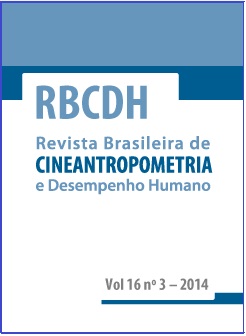Body composition in portuguese adolescents: are physical activity and maturity status sex-specific determinant factors?
DOI:
https://doi.org/10.1590/1980-0037.2014v16n3p247Abstract
The influence of biological maturation and physical activity (PA) on the differences of body composition in adolescents have been little studied. The purpose of this study was to examine if PA and maturity status were sex-specific determinant factors in the adolescents’ body composition. Ninety-four adolescents (50 boys and 44 girls) were evaluated. All anthropometric measures were obtained according to ISAK procedures, bone age was estimated by the TW3 method, and PA was assessed with ActigraphR GT1M, over seven consecutive days. Maturity status explained 33% of the body mass index (BMI) and waist circumference (WC) and 31% of the sagittal abdominal diameter (SAD) in boys. In girls, maturity status explained 27% of the waist-to-hip ratio (WHR), moderate PA explained 17% of the BMI and 12% of the WC, and moderate to vigorous PA explained 11% of the SAD. These results seem to indicate that the determinant factors of the adolescents’ body composition are sex-specific. Maturity status was the main predictive factor in boys and interacted with PA in girls. Our findings support the evidence that researchers need to consider biological maturity when explaining body composition changes in adolescents.



